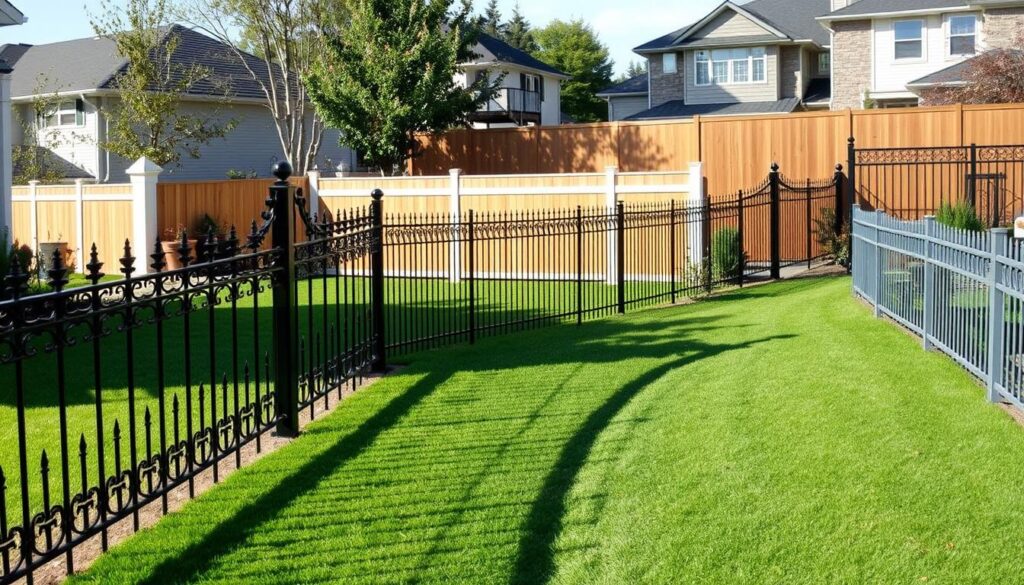Choosing the right residential fencing can be a daunting task, but it’s a crucial decision that can enhance your property’s value and aesthetic appeal. A well-selected fence types for your home not only provides privacy and security but also complements your home’s architecture.
With numerous options available, from classic wood to modern metal designs, selecting the perfect fence requires careful consideration. Whether you’re looking to boost your home’s curb appeal or create a safe haven for your family, understanding the different home fencing options is essential.
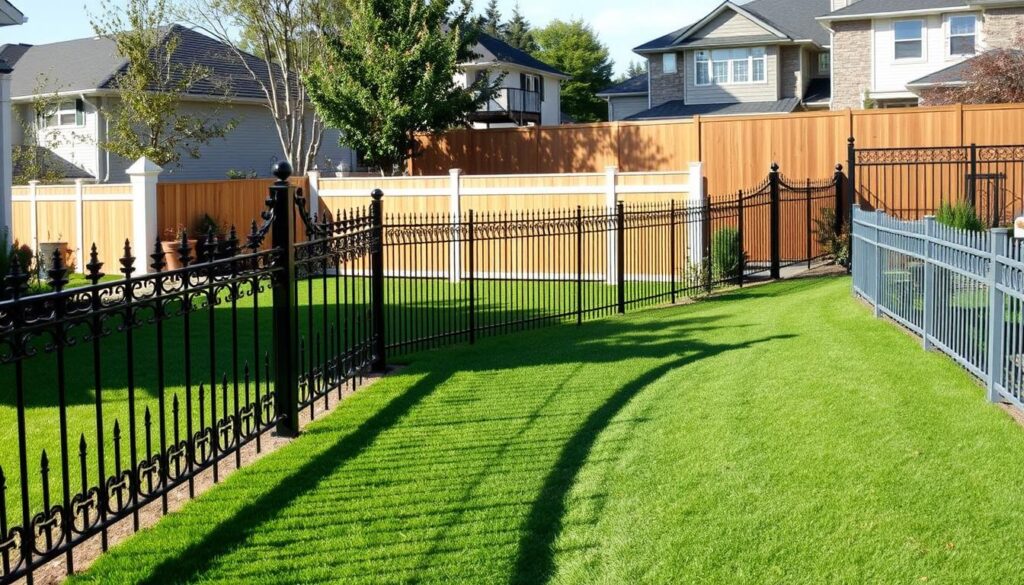
Key Takeaways
- Understand the different materials used for residential fencing.
- Consider factors like durability, maintenance, and cost.
- Choose a fence that complements your home’s architecture.
- Enhance your property’s value and aesthetic appeal.
- Ensure the fence provides the desired level of privacy and security.
Why Your Home Needs the Right Fence
Choosing the right fence for your home is a decision that can significantly impact its overall appeal and functionality. A fence is not just a boundary; it serves multiple purposes that can enhance your living experience.
Defining Your Fencing Goals
Before selecting a fence, it’s essential to define your goals. Are you looking to enhance your home’s curb appeal, or do you need a fence types for your home for security and privacy? Understanding your primary objective will help you choose the most suitable type of fence.
Property Enhancement Benefits
A well-designed fence can significantly boost your property’s value. Different types of fences, such as wood, vinyl, or metal, offer unique aesthetic benefits that can complement your home’s architecture.
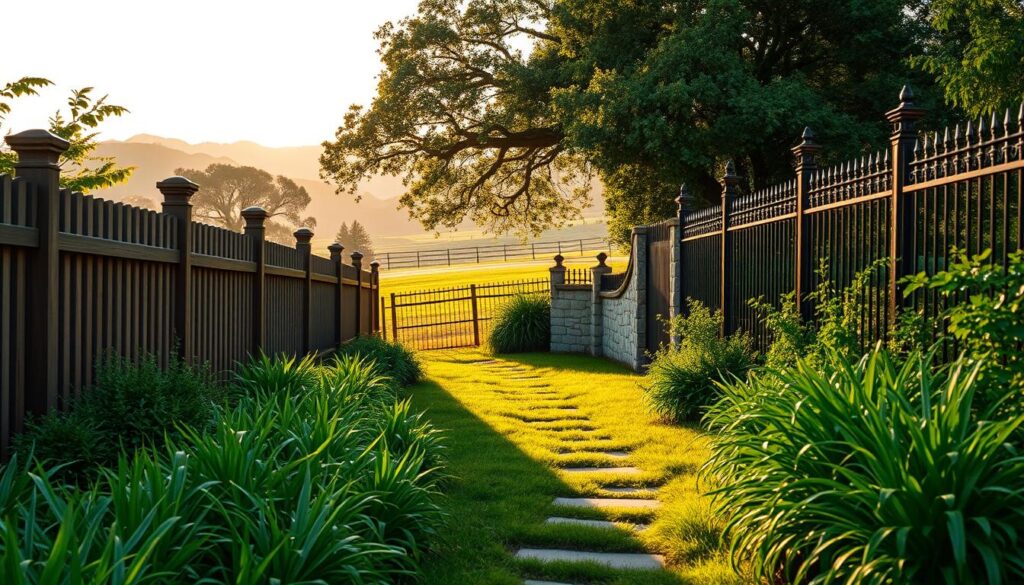
Security and Privacy Considerations
A fence can provide an added layer of security and privacy for your home. The choice of fencing options can deter intruders and create a secluded environment. Consider materials and designs that balance security needs with aesthetic appeal.
| Fencing Type | Security Level | Aesthetic Appeal |
|---|---|---|
| Wood | Medium | High |
| Vinyl | Medium | High |
| Metal | High | Medium |
Fence Types for Your Home: A Comprehensive Guide
Choosing the right fence for your home involves considering various fence materials, styles, and designs that complement your property’s architecture. A well-chosen fence not only enhances your home’s curb appeal but also provides security and privacy.
Material Overview and Comparison
Different fence materials offer unique benefits. Wood fences provide a natural look, while vinyl fences are known for their durability and low maintenance. Metal fences, including aluminum and wrought iron, offer strength and style. Composite materials combine the best of wood and plastic, providing a sustainable option.
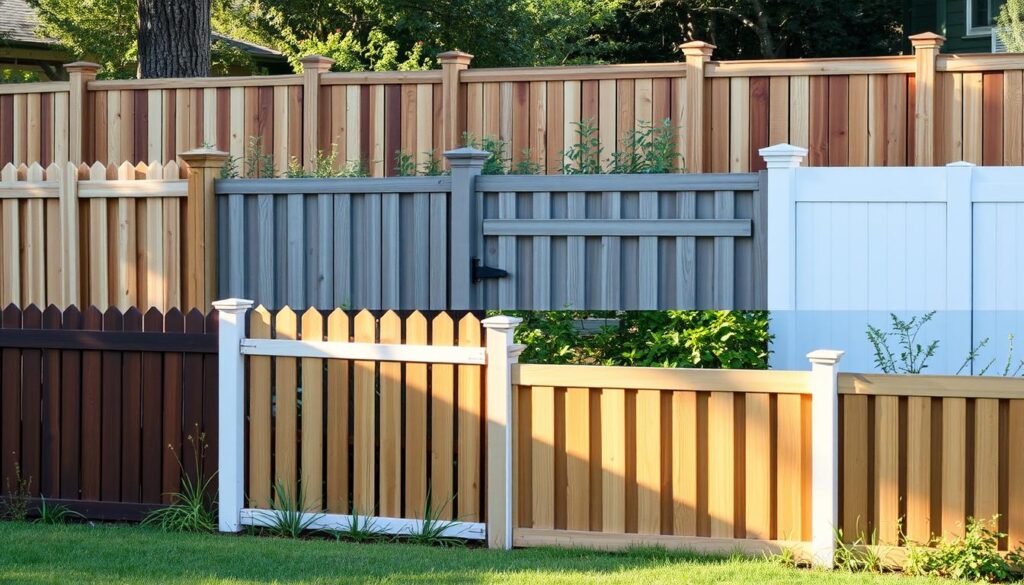
Style and Design Options
Fence styles range from modern and sleek to traditional and ornate. The design you choose should reflect your home’s architecture and your personal taste. Popular styles include picket fences, lattice fences, and privacy fences.
Matching Fences to Your Home’s Architecture
To ensure your fence complements your home, consider the architectural style. For instance, a modern home might suit a sleek metal or composite fence, while a traditional home might be more suited to a wooden picket fence. The key is to create a harmonious balance between your fence and home’s design.
Wood Fences: Timeless Appeal and Versatility
When it comes to fencing options, wood remains a top choice for many American homeowners due to its versatility and classic appeal. Wood fences offer a natural beauty that can complement a variety of home styles, from rustic to modern.
Cedar, Pine, and Redwood Options
Different types of wood offer unique benefits. Cedar, pine, and redwood are among the most popular choices for wood fences.
Durability Differences
Cedar is known for its natural resistance to rot and insects, making it a durable option. Pine is another popular choice, though it may require more maintenance than cedar. Redwood, with its rich color and durability, is also a favored option despite being more expensive.
Climate Suitability
The suitability of these woods varies by climate. For instance, cedar performs well in wet conditions due to its natural resistance to moisture. Pine can be suitable for drier climates but may warp in extremely wet conditions. Redwood is generally durable across various climates.
Popular Wood Fence Styles
Wood fences come in a variety of styles to suit different needs and preferences.
Privacy Fences
Privacy fences are designed to provide seclusion and are typically taller and more solid. They are ideal for homes in densely populated areas.
Picket Fences
Picket fences are a classic choice, offering a charming and welcoming appearance. They are suitable for homes with a more traditional or suburban style.
Post and Rail Designs
Post and rail fences are simple and functional, often used in rural or ranch-style settings. They provide a clear boundary without obstructing views.
Maintenance Requirements and Lifespan
Wood fences require regular maintenance to extend their lifespan. This includes staining or sealing the wood to protect it from the elements.
| Wood Type | Maintenance Frequency | Average Lifespan |
|---|---|---|
| Cedar | Every 2-3 years | 15-20 years |
| Pine | Every 1-2 years | 10-15 years |
| Redwood | Every 3-5 years | 20-25 years |
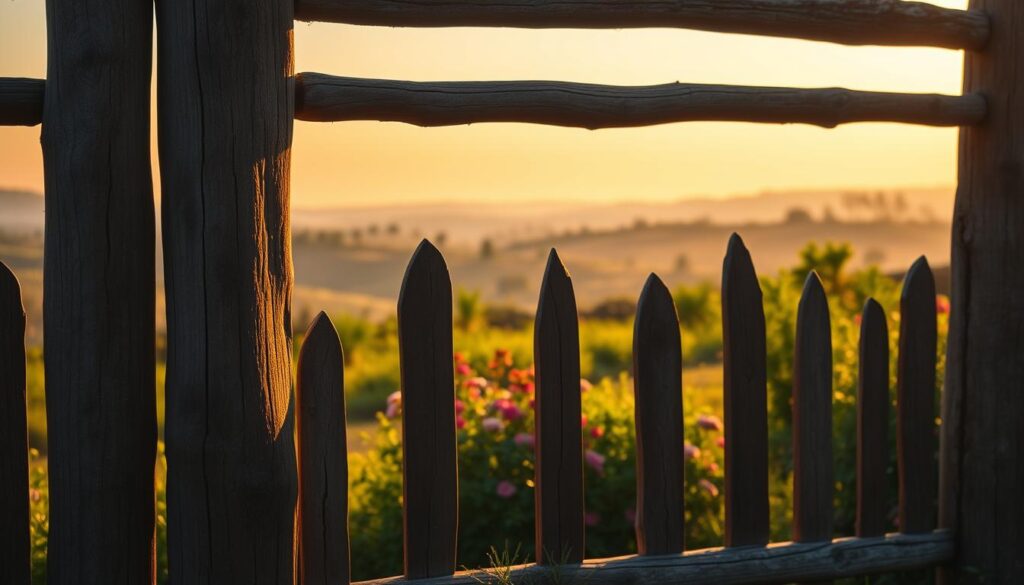
Vinyl Fences: The Low-Maintenance Solution
Vinyl fences have become a popular choice for homeowners seeking a low-maintenance solution. They offer a unique combination of durability, style, and functionality that makes them an attractive option for many.
Durability and Weather Resistance
One of the key benefits of vinyl fences is their ability to withstand various weather conditions. They are resistant to rot, rust, and insect damage, ensuring that they remain in good condition for years to come. Vinyl fencing is also less prone to warping or cracking, making it a reliable choice for homeowners.
Style and Color Variety
Vinyl fences come in a wide range of styles and colors, allowing homeowners to choose the perfect match for their property. From traditional picket fences to more modern designs, there’s a vinyl fence to suit every taste. The color options are also vast, ensuring that the fence complements the home’s exterior.
Installation Considerations
While vinyl fences offer many benefits, proper installation is crucial to ensure their longevity. Homeowners should consider hiring a professional for fence installation to guarantee that the job is done correctly. This includes setting the posts at the right depth and ensuring the fence is level.
Long-Term Cost Benefits
Although the initial cost of vinyl fencing might be higher than some other materials, its long-term benefits can lead to significant cost savings. With minimal maintenance required and a long lifespan, vinyl fences can be a cost-effective solution in the long run. Homeowners can enjoy the benefits of their low-maintenance fencing without the need for frequent repairs or replacements.
In conclusion, vinyl fences offer a compelling combination of durability, style, and low maintenance, making them an excellent choice for homeowners. By considering the factors outlined above, homeowners can make an informed decision about whether vinyl fencing is the right solution for their property.
Metal Fencing Options: Strength Meets Style
For those seeking durability and elegance, metal fencing presents an array of choices tailored to different needs. Metal fencing options are renowned for their strength, style, and ability to enhance property security.
Aluminum Fences: Lightweight and Rust-Resistant
Aluminum fences are a popular choice due to their lightweight nature and resistance to rust. They are ideal for homeowners looking for a low-maintenance fencing solution that still offers a sleek, modern appearance.
Wrought Iron: Classic Elegance and Security
Wrought iron fencing is synonymous with classic elegance and superior security. It offers a timeless aesthetic that can significantly enhance a property’s curb appeal while providing robust protection.
Chain Link: Affordable Functionality
Chain link fencing is a cost-effective solution that provides functionality without compromising on security. It’s a practical choice for homeowners who need a straightforward, durable fence.
Steel Fencing: Maximum Security Solutions
Steel fencing is known for its maximum security capabilities. It’s a strong and durable option, suitable for properties that require high levels of protection.
| Fence Type | Durability | Security | Maintenance |
|---|---|---|---|
| Aluminum | High | Medium | Low |
| Wrought Iron | Very High | High | Medium |
| Chain Link | Medium | Medium | Low |
| Steel | Very High | Very High | Medium |
Composite Fences: The Modern Alternative
The rise of composite fencing has brought a new dimension to home exterior design, combining functionality with aesthetic appeal. Composite fences are made from a combination of materials, typically wood and plastic, offering a durable and low-maintenance alternative to traditional fencing.
Benefits of Wood-Plastic Composite
Composite fencing offers several benefits, including resistance to rot, decay, and insect damage. The wood-plastic composite material is also highly durable and can withstand harsh weather conditions. Eco-friendly and sustainable, composite fences are made from recycled materials, reducing waste and minimizing environmental impact.
Style Options and Customization
Composite fences come in a variety of styles and colors, allowing homeowners to customize their fencing to suit their home’s exterior design. From modern and sleek to traditional and ornate, composite fencing can be tailored to meet individual tastes and preferences.
Environmental Considerations
The eco-friendly nature of composite fencing is one of its most significant advantages. Made from recycled materials, composite fences reduce the demand on natural resources and minimize waste. Additionally, the long lifespan of composite fencing reduces the need for frequent replacements, further reducing environmental impact.
Cost vs. Longevity Analysis
| Fence Type | Initial Cost | Lifespan | Long-term Cost |
|---|---|---|---|
| Composite Fencing | $30-$50 per linear foot | 25-30 years | Low |
| Wood Fencing | $15-$30 per linear foot | 10-15 years | Medium-High |
| Vinyl Fencing | $25-$40 per linear foot | 20-25 years | Low-Medium |
While the initial cost of composite fencing may be higher than some other materials, its long lifespan and low maintenance requirements make it a cost-effective option in the long run.
“Composite fencing offers a unique blend of durability, sustainability, and style, making it an attractive option for homeowners looking for a modern and eco-friendly fencing solution.”
Masonry and Stone Fences: Permanent Elegance
Masonry and stone fences have long been revered for their ability to add a touch of elegance and permanence to residential properties. These structures not only provide a durable boundary but also significantly enhance the aesthetic appeal of a home.
Natural Stone Options for American Homes
Natural stone fences are a popular choice among homeowners due to their unique beauty and durability. Options include:
- Fieldstone: Known for its rustic appearance and durability.
- Bluestone: Prized for its aesthetic appeal and strength.
- Granite: Offers exceptional durability and a sophisticated look.
Brick Fence Designs and Regional Styles
Brick fencing is another masonry option that offers both functionality and style. Regional styles can significantly influence the design, with variations such as:
| Region | Common Brick Style | Characteristics |
|---|---|---|
| Northeast | Traditional Red Brick | Classic, timeless appeal |
| South | Whitewashed Brick | Bright, airy feel |
| West Coast | Modern Clinker Brick | Distinctive, varied textures |
Concrete and Stucco Alternatives
For those seeking a more affordable masonry option, concrete and stucco fences offer viable alternatives. These materials can mimic the appearance of stone or brick at a lower cost.
Combining Masonry with Other Materials
Combining masonry with other fencing materials, such as wood or metal, can create a unique and visually appealing boundary. This approach allows homeowners to leverage the strengths of multiple materials.
Specialized Fence Solutions for Specific Needs
The right fence can do more than just enclose a property; it can address particular requirements such as safety, pet containment, or enhanced security. Homeowners have diverse needs when it comes to fencing, and understanding these specialized solutions can help in making an informed decision.
Pool Safety Fencing Requirements
Pool safety fencing is a critical consideration for homeowners with swimming pools. Not only is it a matter of safety, but it’s also often a legal requirement.
Code Compliance in Different States
Different states have varying regulations regarding pool fencing. For instance, many states require pool fences to be at least 4 feet high and have self-latching gates.
Child-Safe Design Features
Child-safe design features include non-climbable materials and gates that latch out of reach. These features are crucial in preventing accidental drowning.
Pet-Friendly Fencing Options
For pet owners, fencing that keeps pets safe and contained is a top priority. Options include:
- High fences to prevent jumping
- Fences with small gaps to prevent escape
- Electronic pet containment systems
Garden and Decorative Boundaries
Garden and decorative boundaries not only add aesthetic value but can also serve to delineate different areas within a property. Materials like wood, vinyl, and metal are popular for these types of fences.
High-Security Residential Solutions
For homeowners requiring enhanced security, high-security fencing options are available. These include:
- Fences with anti-climb features
- Electric fencing
- Fences topped with security spikes or barbed wire
By understanding these specialized fence solutions, homeowners can choose a fence that not only meets their specific needs but also enhances their property’s overall value and safety.
Regional Considerations for American Homeowners
Choosing the perfect fence involves more than just picking a style; it requires understanding regional considerations that affect its longevity and compliance with local rules.
Climate Impact on Fence Selection
The climate in your region significantly impacts the type of fence you should install. Different materials respond differently to various weather conditions.
Coastal Considerations
In coastal areas, fences need to be resistant to saltwater corrosion. Materials like aluminum or vinyl are often preferred due to their durability in such conditions.
Snow Belt Challenges
In regions with heavy snowfall, fences must be able to withstand the weight of snow. Sturdy materials and designs that allow snow to pass through or be easily removed are advisable.
Arid Region Solutions
In arid regions, fences should be able to withstand intense sunlight and dust. Materials with UV resistance, such as composite fencing, can be a good choice.
HOA and Local Regulations
Before installing a fence, it’s essential to check with your Homeowners Association (HOA) and local authorities for any regulations governing fence installation.
- Height restrictions
- Material specifications
- Boundary guidelines
Neighborhood Aesthetic Trends
Your fence should complement the overall aesthetic of your neighborhood. Understanding local trends can help you choose a fence that enhances your home’s curb appeal.
Installation, Maintenance, and Long-Term Care
The key to maximizing your fence’s lifespan lies in the installation process and ongoing care. A well-installed fence not only enhances your property’s appearance but also withstands environmental challenges more effectively.
DIY vs. Professional Installation
Deciding between DIY and professional installation depends on your skill level, the complexity of the fence design, and local regulations. While DIY projects can save money, professional installers bring expertise that ensures a fence is properly anchored and aligned.
Seasonal Maintenance Requirements
Regular maintenance is crucial for extending the life of your fence. This includes inspecting for damage, cleaning, and applying protective coatings as needed. Seasonal checks can help identify issues before they become major problems.
Repair Techniques and When to Replace
Knowing when to repair versus replace your fence is vital. Minor damages can often be repaired, but significant structural issues may necessitate a new fence. Understanding the signs of wear and tear can save you time and money.
Enhancing Fence Longevity
To maximize your fence’s lifespan, consider factors like material durability, environmental exposure, and maintenance frequency. Regular care and timely repairs can significantly extend the life of your fence.
| Maintenance Task | Frequency | Benefits |
|---|---|---|
| Inspect for damage | Seasonally | Early detection of issues |
| Clean the fence | Annually | Removes dirt and grime |
| Apply protective coatings | As needed | Protects against weathering |
Conclusion: Selecting the Perfect Fence for Your Property
Choosing the right fence for your home is a crucial decision that impacts both the aesthetic appeal and functionality of your property. With various fence types available, including wood, vinyl, metal, composite, masonry, and stone, the selection process can be overwhelming.
When making your fence selection, consider factors such as your home’s architecture, local regulations, and personal preferences. Assess your needs for privacy, security, and durability to narrow down the options.
By understanding the characteristics of different fence materials and styles, you can make an informed decision that enhances your property’s value and meets your specific requirements. Whether you prioritize low maintenance, durability, or style, there’s a perfect fence waiting for you.
Take the time to research, plan, and consult with professionals if needed, to ensure that your chosen fence is both functional and visually appealing.
FAQ
What are the most common types of fences for homes?
The most common types of fences for homes include wood, vinyl, metal, composite, and masonry fences, each offering unique benefits and styles.
How do I choose the right fence for my home’s architecture?
To choose the right fence, consider your home’s style, the surrounding neighborhood aesthetics, and your personal preferences, ensuring the fence complements the property.
What are the benefits of wood fences?
Wood fences offer a timeless appeal, versatility in style, and can be made from various types of wood, such as cedar, pine, and redwood, each with its own durability and characteristics.
Are vinyl fences a good option for homeowners?
Vinyl fences are a great option due to their low maintenance, durability, and weather resistance, making them a cost-effective choice in the long run.
What are the advantages of metal fencing?
Metal fencing, including aluminum, wrought iron, and steel, offers strength, security, and style, with options ranging from lightweight and rust-resistant to maximum security solutions.
How do composite fences compare to traditional fencing options?
Composite fences, made from a combination of wood and plastic, offer durability, low maintenance, and environmental benefits, making them a modern alternative to traditional fencing.
What are the considerations for installing a fence around a pool?
When installing a fence around a pool, it’s crucial to comply with local safety regulations, ensure the fence is child-safe, and consider the style and material that suits your pool area.
How do regional climate conditions affect fence selection?
Regional climate conditions, such as coastal, snowy, or arid environments, impact fence selection, requiring materials and designs that can withstand local weather conditions.
What are the key factors in maintaining my fence?
Regular maintenance, including seasonal inspections, repairs, and cleaning, is essential to extend the lifespan of your fence, regardless of the material.
Should I install a fence myself or hire a professional?
The decision to install a fence yourself or hire a professional depends on your DIY skills, the complexity of the project, and local regulations, with professionals offering expertise and warranty.
How do local regulations and HOA rules impact my fence choice?
Local regulations and HOA rules can dictate the type, height, and style of fence allowed in your area, making it essential to check these before making a decision.

